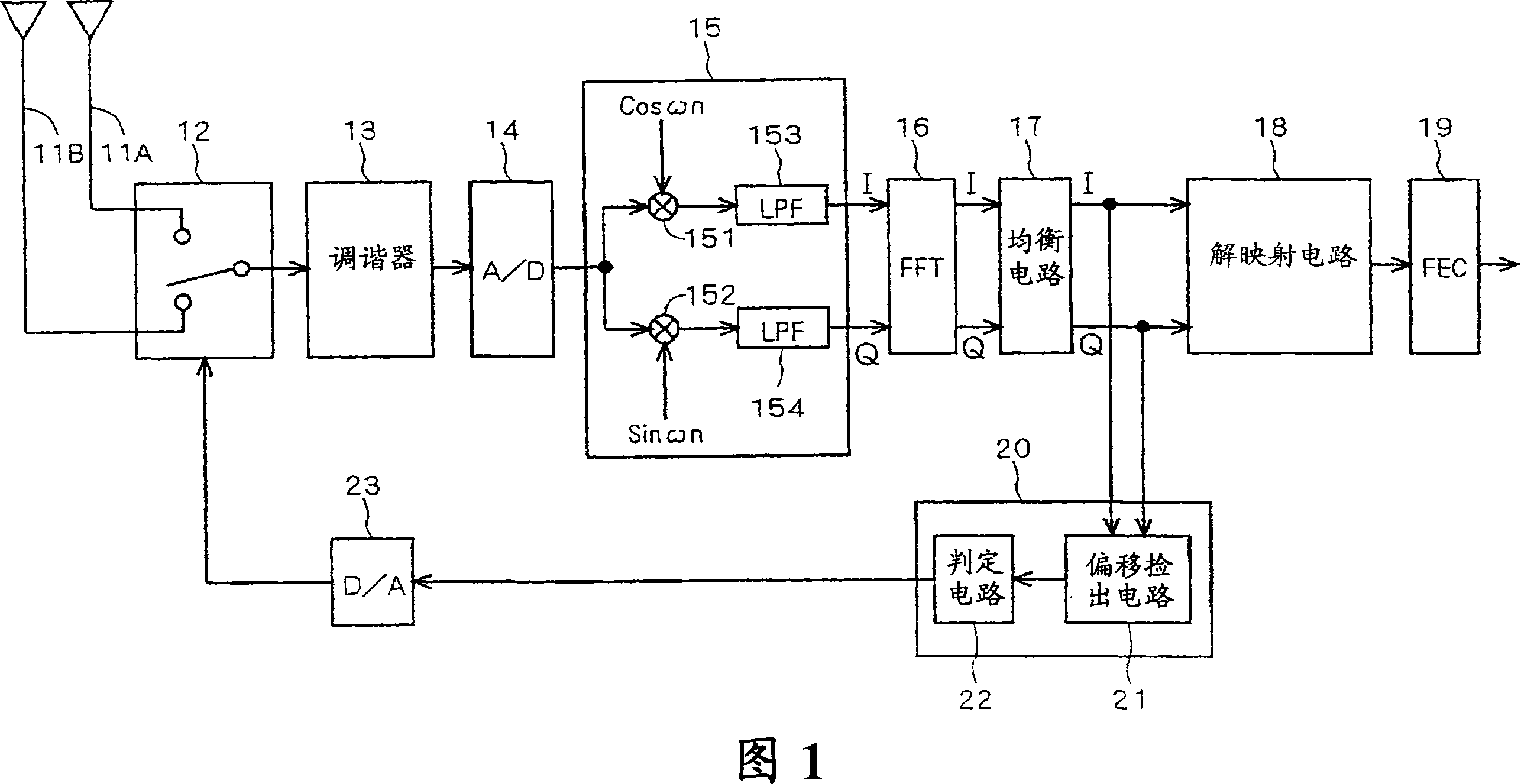Orthogonal frequency division multiplexing receiving device
A receiving device and antenna technology, which is applied in the directions of orthogonal multiplexing system, multiplexing communication, space transmit diversity, etc., can solve the problems of unreceived, low receiving position, and relay fading receiving environment, etc., to achieve improved Adaptability, the effect of reducing the circuit structure
- Summary
- Abstract
- Description
- Claims
- Application Information
AI Technical Summary
Problems solved by technology
Method used
Image
Examples
no. 1 Embodiment
[0057] FIG. 1 is a functional block diagram of an OFDM receiving apparatus according to a first embodiment of the present invention. The OFDM receiving device of this embodiment is a receiving device that can be used in portable equipment such as a mobile phone, a portable digital television, etc., and can receive a layer consisting of only one segment from an OFDM signal composed of multiple layers. device. Then, the OFDM receiving apparatus of this embodiment is a receiving apparatus having two directional antennas 11A and 11B as shown in FIG. 1 and performing diversity reception.
[0058] The RF (radio frequency) signal sent by the OFDM transmitting device (not shown in the figure) is received by two receiving antennas through the transmission path. The received RF signal is output to the tuner 13 via the antenna switching unit 12, and frequency converted by the tuner 13 to become an IF (intermediate frequency) signal. This IF signal is output to an A / D converter through ...
no. 2 Embodiment
[0080] Next, a second embodiment of the present invention will be described. In the second embodiment, antenna switching control is performed based on the bit error rate (BER) of the received signal. Fig. 6 is a block diagram of an OFDM receiving apparatus related to the second embodiment. In the figure, the same structures as those of the first embodiment are denoted by the same reference numerals. Differences from the first embodiment will be described below.
[0081] As shown in FIG. 6 , this OFDM receiving apparatus has a judgment circuit 31 to which a bit error rate signal is input from an FEC circuit 19 . Specifically, the FEC circuit 19 corrects errors of the signal by viterbi decoding, but the viterbi decoding circuit counts the number of occurrences of bit errors that have occurred while performing error correction processing. Based on the count value, the FEC circuit 19 can calculate the bit error rate. Then, the bit error rate signal is output to the judging cir...
no. 3 Embodiment
[0085] Next, a third embodiment of the present invention will be described. In the third embodiment, switching of antennas is controlled based on the C / N ratio (Carrier to Noise ratio) of the received signal. Fig. 7 is a block diagram of an OFDM receiving apparatus related to the third embodiment. In the drawings, the same structures as those of the first embodiment are denoted by the same reference numerals. Differences from the first embodiment will be described below.
[0086] As shown in FIG. 7 , this OFDM receiving apparatus is provided with a C / N calculation unit 41 which calculates the C / N ratio of the received signal based on the calculation result of the FFT circuit 16 . The C / N ratio is the ratio of signal to noise, and the higher the value, the stronger the signal power. In addition, the C / N calculation unit 41 may calculate the C / N ratio using the signal before the FFT calculation. Then, the C / N calculation unit 41 outputs the C / N ratio signal of the received s...
PUM
 Login to View More
Login to View More Abstract
Description
Claims
Application Information
 Login to View More
Login to View More - R&D
- Intellectual Property
- Life Sciences
- Materials
- Tech Scout
- Unparalleled Data Quality
- Higher Quality Content
- 60% Fewer Hallucinations
Browse by: Latest US Patents, China's latest patents, Technical Efficacy Thesaurus, Application Domain, Technology Topic, Popular Technical Reports.
© 2025 PatSnap. All rights reserved.Legal|Privacy policy|Modern Slavery Act Transparency Statement|Sitemap|About US| Contact US: help@patsnap.com



